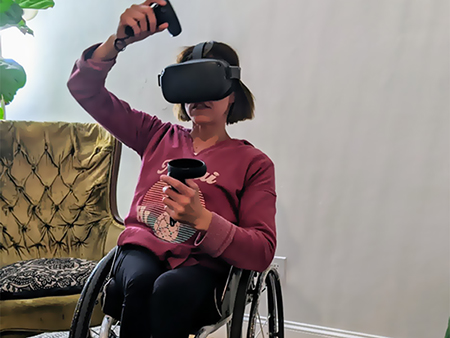 The new gaming system uses commercially available technology which helps to reduce costs.A newly developed telehealth program using virtual reality gaming is demonstrating promise for improving health among children with physical disabilities. The “tele-exergaming” program, developed by researchers in the UAB/Lakeshore Foundation Research Collaborative, is the result of a first-of-its-kind pilot study using this technology in rehabilitation.
The new gaming system uses commercially available technology which helps to reduce costs.A newly developed telehealth program using virtual reality gaming is demonstrating promise for improving health among children with physical disabilities. The “tele-exergaming” program, developed by researchers in the UAB/Lakeshore Foundation Research Collaborative, is the result of a first-of-its-kind pilot study using this technology in rehabilitation.
“These preliminary findings are quite promising given the high rates of sedentary behavior and associated health risks exhibited by children and youth with physical disabilities,” said James Rimmer, Ph.D., Director of the UAB/Lakeshore Research Foundation Research Collaborative and Lakeshore Foundation Endowed Chair in Health Promotion and Rehabilitation Sciences in the UAB School of Health Professions, University of Alabama at Birmingham.
The scientist behind the telehealth program is Byron Lai, Ph.D., with the UAB-Lakeshore Research Collaborative. Lai, who is also an assistant professor of pediatrics, has published a case study demonstrating that children who use wheelchairs could achieve unprecedented levels of health-enhancing exercise at home, using only their arms.
Lai reports that two youths achieved an average of 200 minutes of moderate-intensity exercise per week. The program includes telehealth technology to provide low-dose behavioral coaching and monitoring, as well as a new virtual reality gaming console developed by Facebook, called the Oculus Quest. The Quest includes built-in motion-tracking, which allows the user to play without having to plug into a computer, eliminating wires and a costly gaming computer.
“The protocol within the virtual reality program uses commercially available software and equipment, making it a cost-effective system that can be disseminated on a large scale to help youth with disabilities enhance their health through exercise,” Lai said.
The monitoring equipment, Oculus Quest headset, and games together cost approximately $500. The protocol uses a system of equipment that captures heart rate from an accurate and reliable heart rate monitor and sends the data to a free mobile app for monitoring by the participant, from which the data can then be sent for review by a telehealth coach.
Lai’s study, “Feasibility of a Commercially Available Virtual Reality System to Achieve Exercise Guidelines in Youth with Spina Bifida: Mixed Methods Case Study,” was recently published in the Journal of Medical Internet Research, Serious Games.
What began in a research lab made its way into a community-based program at Lakeshore Foundation, a nonprofit organization delivering fitness, sports and recreation to people with physical disabilities and chronic health conditions. Lakeshore created a home-loan program where youth members could rent or borrow the headsets to exercise at their homes, as well as participate in an online group-based exercise program. The group exercise program came at the perfect time, during the peak of the COVID-19 pandemic, and offered a way for children to get fit, improve their health and socially interact with peers with disabilities while staying safe at home. The gaming programs remain available to Lakeshore members who would like to try it out at home.
To view the video, click here.
The benefits of the virtual reality gaming did not stop at Lakeshore. It is also being used in the Pediatric Rehabilitation Division at Children’s of Alabama in Birmingham. Two intensive care patients, who struggled with conventional physical therapy, flourished when using the gaming technology. Lai conducted a feasibility study demonstrating that virtual reality gaming with adaptive software could be safely used by children with disabilities during the early critical stage of their rehabilitation while in the intensive care unit.
The games are immersive, and participants do not have to walk, allowing participation from a wheelchair or bed. Software can also be included to make the equipment fully accessible for people with minimal function of their arms.
“Virtual reality is the future of active video gaming, and the technology is now at a perfect point where motion tracking is good, but not so good that it prevents people with disabilities from participation in most games,” Lai said. “The technology is now finally low-cost and comparable to conventional gaming consoles like the PlayStation or Xbox, allowing virtual reality to be accessible to a much wider range of consumers.”
Additional research is necessary to confirm the benefits of these devices on improving health among youths with disabilities. Lai has submitted a grant to the National Institutes of Health to examine the benefits of virtual reality gaming on cardiometabolic health among youths with disabilities. Additionally, Lai and Rimmer are working on creating a state-of-the-art gaming lab that will utilize virtual reality and adaptive gaming equipment to advance research in this area and build an e-sports arena and gaming community for people with disabilities.  Exercise procedure
Exercise procedure
